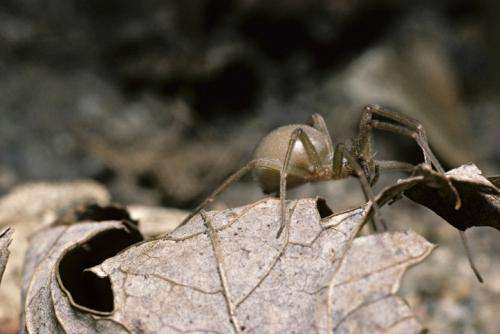Engineered spider toxin could be the future of anti-venom vaccines

New engineered spider protein could be the start of a new generation of anti-venom vaccines, potentially saving thousands of lives worldwide. The new protein, created from parts of a toxin from the reaper spider, is described today in the journal Vaccine.
The researchers behind the study, from the Universidade Federal de Minas Gerais in Brazil, say that the engineered protein may be a promising candidate for developing therapeutic serums or vaccines against other venoms.
Reaper spiders, or brown spiders, are a family of species found all over the world that produce harmful venoms. The toxic bite of these spiders causes skin around the bite to die, and can lead to more serious effects like kidney failure and haemorrhaging. These Loxosceles spiders are most prevalent in Brazil, where they cause almost 7,000 human accidents every year.
The new study describes an engineered protein made of three pieces of a venom toxin from the Loxosceles intermedia spider. The engineered protein is not itself toxic, and gives effective protection against the effects of the pure spider venom in animal models.
"In Brazil we see thousands of cases of people being bitten by Loxosceles spiders, and the bites can have very serious side-effects," said Dr. Chávez-Olortegui, corresponding author of the study. "Existing anti-venoms are made of the pure toxins and can be harmful to people who take them. We wanted to develop a new way of protecting people from the effects of these spider bites, without having to suffer from side-effects."
Current approaches to protecting against venom involve giving the venom to animals, and taking the resulting antibodies for the serum. These antibodies enable the human immune system to prepare to neutralize venom from bites. Although they are somewhat effective, the production of anti-venoms like these is problematic because animals are required to produce them, and these animals suffer from the effects of the venom.
The new protein is engineered in the lab, without the need for the venomous animals. It is made up of three proteins, so it can protect against more than one kind of toxin at a time. The protein is not harmful to the immunized animal that produces the antibodies. It is also more effective than existing approaches, and easier to produce than preparing crude venom from spiders.
"It's not easy taking venom from a spider, a snake or any other kind of venomous animal," said Chávez-Olortegui. "With our new method, we would be able to engineer the proteins in the lab without having to isolate whole toxins from venom. This makes the whole process much safer."
The researchers tested their new protein on rabbits: all immunized animals showed an immune response similar to the way they respond to the whole toxin. The engineered protein was effective for venom of the L. intermedia and L. gaucho sub-species, which have similar toxins. Immunized rabbits were protected from skin damage at the site of venom injection, and from haemorrhaging.
This engineered protein may be a promising candidate for therapeutic serum development or vaccination in the future.
More information: "Generation and characterization 1 of a recombinant chimeric protein (rCpLi) consisting of B-cell epitopes of a dermonecrotic protein from Loxosceles intermedia spider venom" by T. M. Mendes, D. Oliveira, L. Minozzo, R. Machado de Avila, C. Duarte, C. Dias-Lopes, G. Guimarães, L. Felicori, J. C. Minozzo, C. Chávez-Olortegui, Vaccine, dx.doi.org/10.1016/j.vaccine.2013.03.048
















